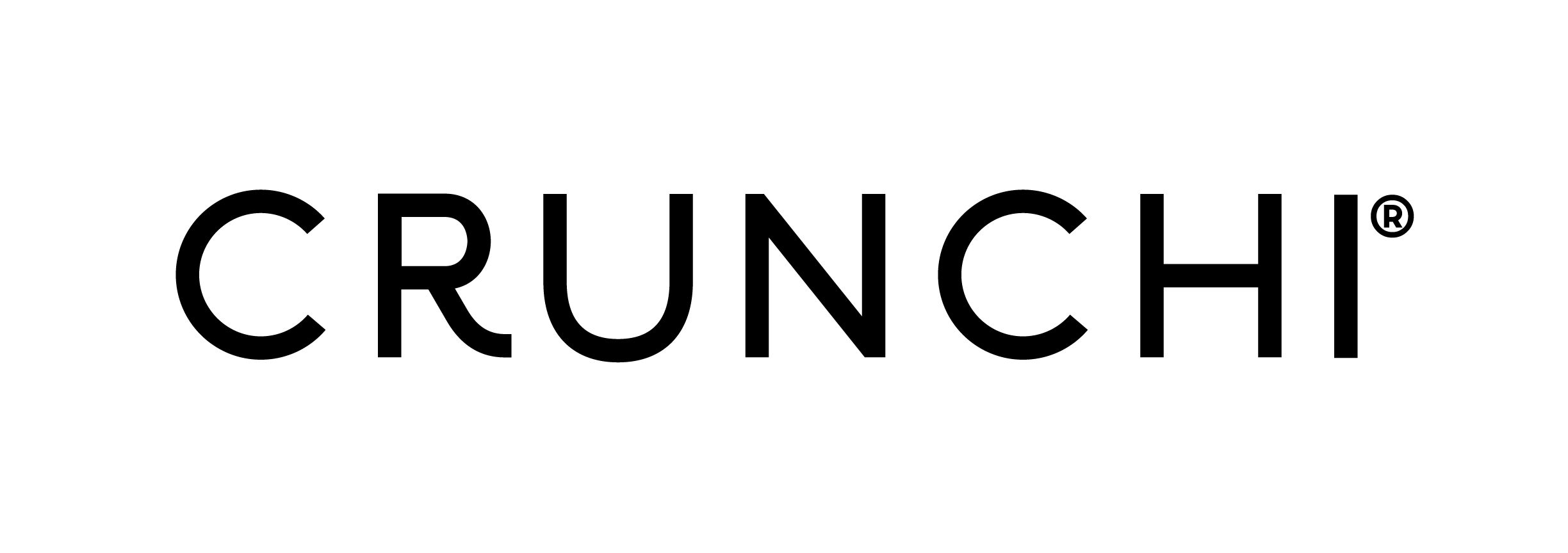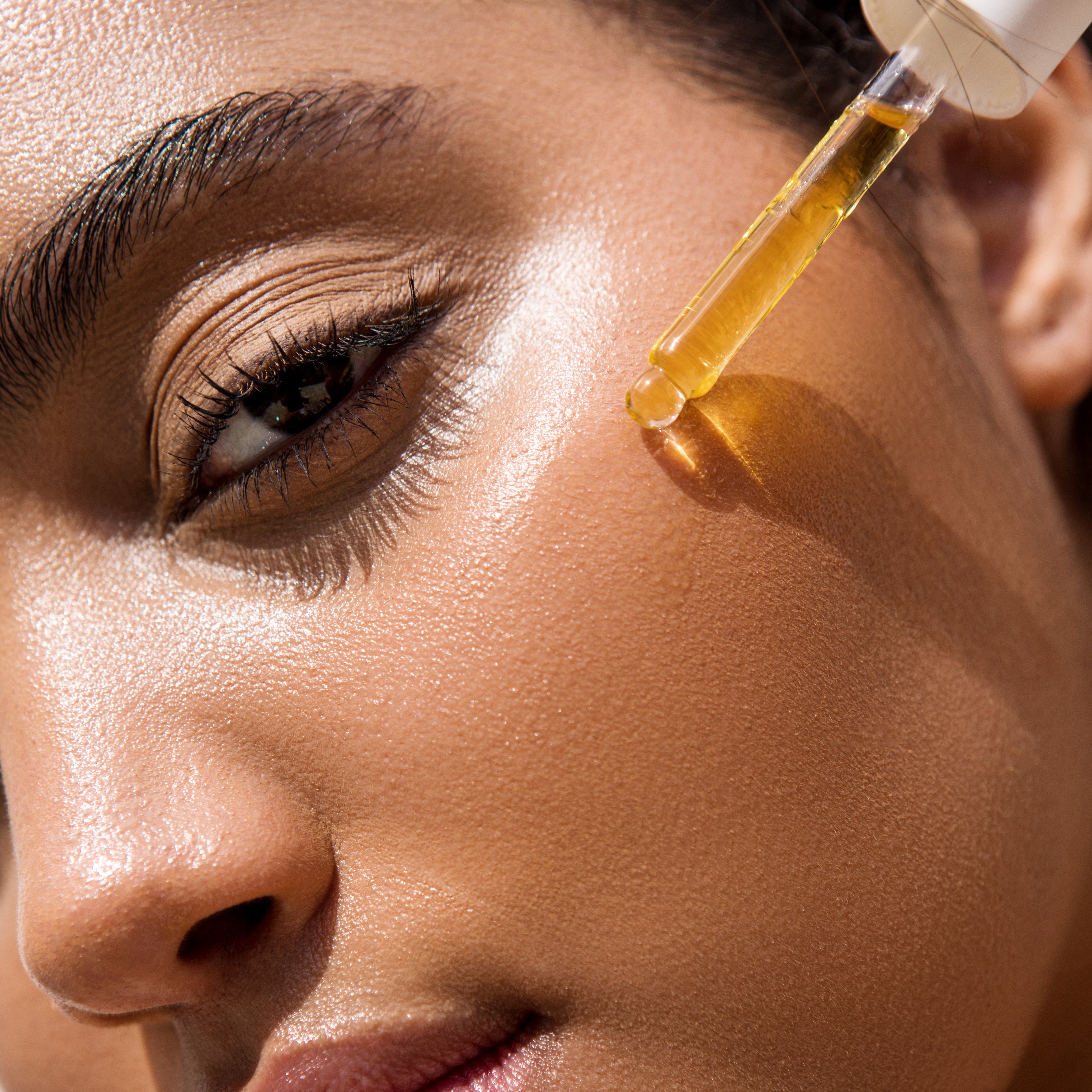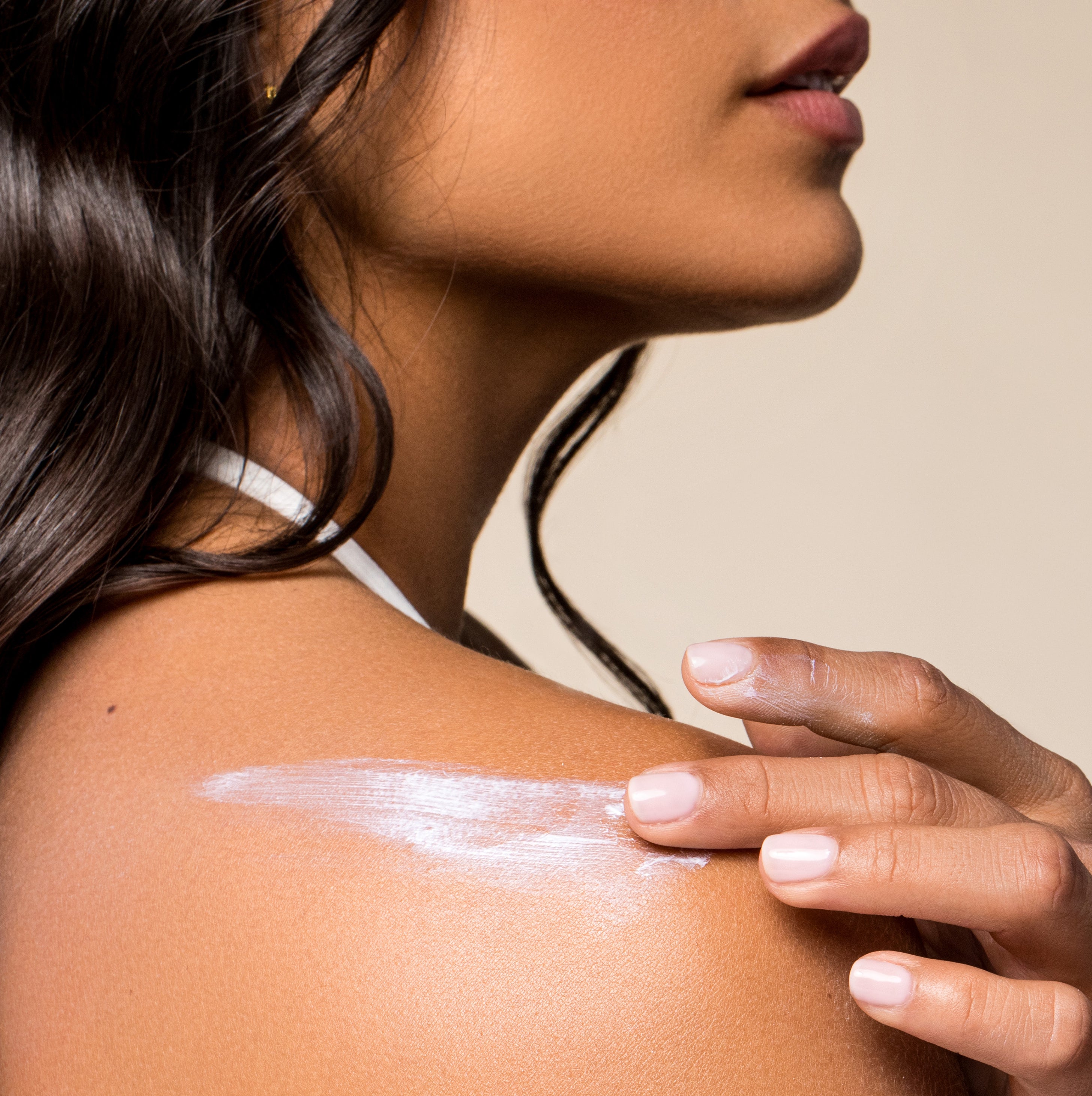Many ingredients don't make the cut with our products.
Over 10,000 ingredients don't make the cut.
Our published Banished List represents a small fraction of the harmful ingredients banned from use in any Crunchi product. If we were to list every single ingredient we prohibit it would be ever-growing and easily reach into the tens of thousands.
Our Banished List includes 50 of the worst offenders and most commonly found ingredients used in conventional cosmetics, as well as many products marketed as "natural" or "clean".
1, 4-Dioxane
A contaminant that is not required to be listed on an ingredient label in the US. It is a by-product of the ethoxylation process in which carcinogenic ethylene oxide is reacted with other ingredients to make them less harsh on the skin. The EPA (U.S. Environmental Protection Agency) has classified 1,4-dioxane as likely to be carcinogenic to humans. The FDA studies showed that 1,4-dioxane can penetrate human skin. 1,4-dioxane can be reduced or removed from a product through the vacuum-stripping process. However, independent tests show that many manufacturers fail to do so.
Sources:
https://www.fda.gov/Cosmetics/ProductsIngredients/PotentialContaminants/ucm101566.htm
http://www.safecosmetics.org/get-the-facts/chemicals-of-concern/14-dioxane/
2-Bromo-2-Nitropropane-1,3-Diol (Bromopol)
An antimicrobial preservative that slowly releases carcinogenic formaldehyde into a product over time (see Formaldehyde). People may develop a contact allergy to formaldehyde or to the ingredient itself. The American Society of Contact Dermatitis lists 2-bromo-2-nitropropane-1,3-diol as one of the allergens even in concentrations as low as 0.5%. In the presence of amines (such as triethanolamine, diethanolamine, and morpholine) in a product, 2-bromo-2-nitropropane-1,3-diol can form nitrosamines, which can penetrate the skin and increase the risk of cancer. Longer storage times and higher temperatures increase the amount of formaldehyde released from 2-bromo-2-nitropropane-1,3-diol, which can lead to higher risks of health problems.
Sources:
http://www.safecosmetics.org/get-the-facts/chemicals-of-concern/formaldehyde/
https://online.personalcarecouncil.org/ctfa-static/online/lists/cir-pdfs/pr208.pdf
https://www.cancer.org/cancer/cancer-causes/formaldehyde.html
Aluminum Hydroxide (CI 77002)
Used in many types of cosmetics and personal care products as a colorant. The carcinogenic risk from aluminum and its compounds has not been evaluated by the International Agency for Research on Cancer (IARC). However, IARC has classified “aluminum production” as carcinogenic to humans. Aluminum is a pro-oxidant and could significantly increase the potential for oxidative skin damage.
Sources:
https://www.ncbi.nlm.nih.gov/pmc/articles/PMC2782734/
https://www.sciencedaily.com/releases/2007/08/070812084458.htm
Benzalkonium Chloride
(Additional Names: Alkyldimethylbenzylammonium chloride)
Used as a foaming and cleansing agent or as an antimicrobial preservative. It is a well-recognized irritant, and there is evidence that it may cause a contact allergy at concentrations as low as 0.1%. It decreased fertility in both sexes of mice when benzalkonium chloride was used to clean their cages.
Sources:
https://www.sciencedirect.com/science/article/pii/S0890623814001920
https://www.ncbi.nlm.nih.gov/pubmed/18503686
https://online.personalcarecouncil.org/ctfa-static/online/lists/cir-pdfs/pr142.pdf
https://www.ncbi.nlm.nih.gov/pubmed/term=Benzalkonium+Chloride%3A+A+Known+Irritant+
and+Novel+Allergen+%3A+Dermatitis
Benzophenones
(Additional Names: Benzophenone-1, Benzophenone-2, Benzophenone-3 aka Oxybenzone, Benzophenone-4, Benzophenone-5, Benzophenone-6 Benzophenone-8, Benzophenone-9, Benzophenone-11, Benzophenone-12)
Benzophenones are photostabilizers used in cosmetics. Photostabilizers have a photoprotective effect on the skin. In 2012, benzophenone was added as a carcinogen to the California EPA’s Proposition 65 List of Chemicals Known to the State to Cause Cancer or Reproductive Toxicity. The evidence linking the benzophenone chemicals to endocrine disruption is complex, and studies show that different benzophenones may have difference hormone-disrupting effects. Because they commonly cause contact allergic dermatitis, benzophenones were declared the Contact Allergen of the Year for 2014 by the American Contact Dermatitis Society (ACDS).
Sources:
https://oehha.ca.gov/media/downloads/proposition-65/p65122917_0.pdf
https://www.ncbi.nlm.nih.gov/pmc/articles/PMC4997468/
http://www.safecosmetics.org/get-the-facts/chemicals-of-concern/benzophenone/
BHA & BHT
BHA (Butylated Hydroxyanisole)
A preservative often used as an antioxidant in cosmetic products, especially lipstick and eyeshadow. The U.S. National Toxicology Program, a part of the National Institutes of Health, has classified BHA as "reasonably anticipated to be a human carcinogen" based on evidence of carcinogenicity in experimental animals. BHA has been added as a carcinogen to the California EPA’s Proposition 65 List of Chemicals Known to the State to Cause Cancer or Reproductive Toxicity. Moreover, studies show that BHA exhibits some endocrine-disrupting effects, and the European Union has listed it as an endocrine disruptor.
Sources:
https://ntp.niehs.nih.gov/ntp/roc/content/profiles/butylatedhydroxyanisole.pdf
https://www.ncbi.nlm.nih.gov/pmc/articles/PMC4462476/
https://oehha.ca.gov/media/downloads/proposition-65/p65122917_0.pdf
http://ec.europa.eu/environment/chemicals/endocrine/strategy/substances_en.htm
BHT (Butylated Hydroxytoluene)
A toluene-based ingredient used as a preservative in food and personal care products. There is a lot of controversy surrounding BHT because of its suspected potential endocrine-disrupting and carcinogenic effects.
Sources:
https://pdfs.semanticscholar.org/3203/50af38be626d835d9572788fbc2dcb646e63.pdf
Bismuth Oxychloride
A mineral used as a makeup colorant that provides a shiny effect.Anecdotally, we hear that some people may break out or itch from bismuth oxychloride.While
there are no scientific studies to attest to that, we prefer to err on
the side of caution and offer makeup without this mineral.
Sources:
https://www.livestrong.com/article/248442-makeup-for-sensitive-acne-prone-skin/
https://rosacea-support.org/community/viewtopic.php?t=127
http://greenbeautyteam.com/answers-advice/makeup/ingredients-mineral-makeup-terrible-arent/
Boric Acid
(Additional Names: Borax, Sodium Borate, Sodium Tetraborate or Disodium Tetraborate)
A preservative, emulsifier, and pH adjuster in cosmetics and personal care products. It is also used as a pesticide that poisons insects, fungus, and weeds. At high doses, Boric Acid causes testicular atrophy, impaired fetal skeletal development, and decreased birth weight in animals. In Europe, sodium borate and boric acid are not allowed to be used on peeling or irritated skin or in products for children under 3 years due to absorption concerns.
Sources:
https://www.regulations.gov/document?D=EPA-HQ-OPP-2005-0062-0004
https://www.ncbi.nlm.nih.gov/pubmed/27466210
https://www.ewg.org/enviroblog/2011/02/borax-not-green-alternative-its-cracked-be#.WsqkjGaZPOQ
https://online.personalcarecouncil.org/ctfa-static/online/lists/cir-pdfs/pr215.pdf
Butoxyethanol
(Additional Name: 2-Butoxyethanol)
Used as a solvent in hair dyes, nail polishes, lacquers, vanishes, and inks. In one study, people exposed to high levels of 2-butoxyethanol for several hours reported irritation of the nose and eyes, headache, a metallic taste in their mouths, and vomiting. Animal studies show destruction of red blood cells and damage to organs from exposure to butoxyethanol.
Source:
https://ec.europa.eu/health/ph_risk/committees/04_sccp/docs/sccp_o_095.pdf
Carbon Black
(Additional Names: CI 77266, Black 2, D&C Black No. 2, acetylene black, channel black furnace black, lamp black, thermal black)
A black powder used as a pigment in cosmetics. It is manufactured by the combustion of aromatic petroleum oil feedstock and consists essentially of pure carbon. The International Agency for Research on Cancer has classified it as possibly carcinogenic to humans. It may contain carcinogenic PAHs (Polycyclic Aromatic Hydrocarbons) as a contaminant.
Sources:
https://monographs.iarc.fr/ENG/Monographs/vol93/mono93.pdf
http://www.safecosmetics.org/get-the-facts/chemicals-of-concern/carbon-black/
https://www.accessdata.fda.gov/scripts/cdrh/cfdocs/cfcfr/CFRSearch.cfm?fr=74.2052
https://ec.europa.eu/health/scientific_committees/consumer_safety/docs/sccs_o_144.pdf
Coal Tar
A thick liquid obtained as a by-product in the destructive distillation of bituminous coal at very high temperatures. It is believed that over 10,000 different compounds make up coal tar, but only 400 have been identified. It is used as a biocide to treat various skin conditions, such as eczema, psoriasis, and dandruff. Coal tar has been found to be comedogenic and a contact allergen. Moreover, it is known to be a human carcinogen based on sufficient evidence of carcinogenicity from studies in humans.
Sources:
https://ntp.niehs.nih.gov/ntp/roc/content/profiles/coaltars.pdf
https://www.dermnetnz.org/topics/coal-tar/
https://www.cancer.gov/about-cancer/causes-prevention/risk/substances/coal-tar
https://online.personalcarecouncil.org/ctfa-static/online/lists/cir-pdfs/pr281.pdf
Cyclic Siloxanes
Cyclic siloxanes, also known as D4 (octamethylcyclotetrasiloxane), D5 (decamethylcyclopentasiloxane), and D6 (dodecamethylcyclohexasiloxane), are a group of synthetic chemicals primarily used in cosmetics, personal care products, and industrial applications. D4, in particular, has been linked to reproductive toxicity in animal studies, while D5 and D6 are considered potential environmental pollutants.
Diazolidinyl Urea
An antimicrobial preservative that slowly releases carcinogenic formaldehyde into a product over time (see Formaldehyde). People may develop a contact allergy to formaldehyde or to the ingredient itself. The American Society of Contact Dermatitis lists diazolidinyl urea and formaldehyde as contact allergens, even in concentrations as low as 1%. Longer storage time and higher temperatures increase the amount of formaldehyde released from diazolidinyl urea, which can lead to higher risks of health problems.
Sources:
https://online.personalcarecouncil.org/ctfa-static/online/lists/cir-pdfs/pr137.pdf
http://www.safecosmetics.org/get-the-facts/chemicals-of-concern/formaldehyde/
https://www.cancer.org/cancer/cancer-causes/formaldehyde.html
Diethyl Phthalate (DEP)
(Additional Name: DEP)
One of the phthalates, commonly used as a fixative in synthetic fragrances to make fragrances last longer. We do not use any synthetic fragrance in our products. The research on DEP is less conclusive than on other phthalates, but there is some evidence that it may interfere with the normal function of the endocrine system and cause birth defects in animals.
Sources:
https://www.fda.gov/Cosmetics/ProductsIngredients/Ingredients/ucm128250.htm
http://www.safecosmetics.org/get-the-facts/chemicals-of-concern/phthalates/
https://www.ncbi.nlm.nih.gov/pmc/articles/PMC1241863/pdf/ehp0112-000331.pdf
https://www.atsdr.cdc.gov/substances/toxsubstance.asp?toxid=112
DMDM Hydantoin
An antimicrobial preservative that slowly releases carcinogenic formaldehyde into a product over time (see Formaldehyde). People may develop a contact allergy to formaldehyde or to the ingredient itself. The American Society of Contact Dermatitis lists DMDM hydantoin and formaldehyde as allergens, even in concentrations as low as 1%. Longer storage time and higher temperatures increase the amount of formaldehyde released from DMDM hydantoin, which can lead to higher risks of health problems.
Sources:
https://online.personalcarecouncil.org/ctfa-static/online/lists/cir-pdfs/pr154.pdf
http://www.safecosmetics.org/get-the-facts/chemicals-of-concern/formaldehyde/
https://www.cancer.org/cancer/cancer-causes/formaldehyde.html
Ethanolamine Compounds (MEA/DEA/TEA)
(Additional Names: MEA/DEA/TEA)
Clear, colorless, thick liquids with ammonia-like odors. At higher concentrations, ethanolamines may increase the risk of asthma and skin irritation. They may break down in the product and form nitrosamines that are linked to cancer.
Sources:
https://online.personalcarecouncil.org/ctfa-static/online/lists/cir-pdfs/pr594.pdf
https://online.personalcarecouncil.org/ctfa-static/online/lists/cir-pdfs/PR575.pdf
https://online.personalcarecouncil.org/ctfa-static/online/lists/cir-pdfs/PR604.pdf
https://ntp.niehs.nih.gov/ntp/roc/content/profiles/nitrosamines.pdf
Ethoxylated Ingredients
Ethoxylated Ingredients are a group of ingredients made by the process of ethoxylation in which carcinogenic ethylene oxide is reacted with other ingredients to make them less harsh on the skin. As a result of the ethoxylation process, 1,4-dioxane is created and can be left behind in the product. 1,4-dioxane can be reduced or removed from a product through the vacuum-stripping process. But independent tests show that many manufacturers fail to do so. The U.S. Environmental Protection Agency (“EPA”) has classified 1,4-dioxane as “likely to be carcinogenic to humans.” United States Food and Drug Administration (“FDA”) studies showed that 1,4-dioxane can penetrate human skin.
Sources:
https://www.fda.gov/Cosmetics/ProductsIngredients/PotentialContaminants/ucm101566.htm
http://www.safecosmetics.org/get-the-facts/chemicals-of-concern/14-dioxane/
Ethylenediaminetetraacetic Acid (EDTA)
Ethylenediaminetetraacetic Acid (EDTA) and its salts Calcium Disodium EDTA, Diammonium EDTA, Dipotassium EDTA, Disodium EDTA, Tetrasodium EDTA, Tripotassium EDTA, and Trisodium EDTA
Bind metal ions and help maintain clarity, protect fragrance compounds, and prevent rancidity of cosmetic and personal care products. While they are not found to be harmful, they enhance the dermal penetration of other ingredients contained in a product.
Sources:
https://online.personalcarecouncil.org/ctfa-static/online/lists/cir-pdfs/pr285.pdf
Formaldehyde & Formaldehyde Releasing Agents
Formaldehyde
Formaldehyde is released by a number of cosmetic preservatives, including diazolidinyl urea, imidazolidinyl urea, DMDM hydantoin, quaternium-15, 2-bromo-2-nitropropane-1,3-diol, and sodium hydroxylmethylglycinate. The International Agency for Research on Carcinogens (“IARC”) has classified formaldehyde as 'carcinogenic to humans.' The American Society of Contact Dermatitis lists it as one of the core allergens, even in concentrations as low as 1%. Longer storage times and higher temperatures increase the amount of formaldehyde released from the formaldehyde-releasers.
Sources:
https://online.personalcarecouncil.org/ctfa-static/online/lists/cir-pdfs/pr209.pdf
https://www.cancer.org/cancer/cancer-causes/formaldehyde.html
https://www.contactderm.org/i4a/pages/index.cfm?pageID=3563
http://www.safecosmetics.org/get-the-facts/chemicals-of-concern/formaldehyde/
Formaldehyde-Releasing Preservatives
(Additional Names: DMDM Hydantoin, Diazolidinyl Urea, Imidazolidinyl Urea, Quaternium-15, 2-Bromo-2-Nitropropane-1,3-Diol, Methenamine, and Sodium Hydroxymethylglycinate)
Formaldehyde-releasing preservatives release a small amount of formaldehyde into a product over time. The International Agency for Research on Carcinogens (“IARC”) has classified formaldehyde as carcinogenic to humans. The American Society of Contact Dermatitis lists it as one of the core allergens, even in concentrations as low as 1%. Longer storage times and higher temperatures increase the amount of formaldehyde released via the formaldehyde-releasers.
Sources:
https://online.personalcarecouncil.org/ctfa-static/online/lists/cir-pdfs/pr209.pdf
https://www.cancer.org/cancer/cancer-causes/formaldehyde.html
https://www.contactderm.org/i4a/pages/index.cfm?pageID=3563
http://www.safecosmetics.org/get-the-facts/chemicals-of-concern/formaldehyde/
Grapefruit Seed Extract
(Additional Names: Citrus Grandis (Grapefruit) Seed Extract or GSE)
An antimicrobial preservative used in cosmetic products. Numerous tests by independent researchers have shown that its antimicrobial properties are due to synthetic preservatives contained in it, not the extract itself. The synthetic preservatives found in GSE include benzalkonium chloride, triclosan, or methylparaben, which are all on our Banished Ingredients list due to toxicity concerns.
Sources:
https://www.ncbi.nlm.nih.gov/pubmed/10399191
https://www.ncbi.nlm.nih.gov/pubmed/16719494
https://www.ncbi.nlm.nih.gov/pubmed/16159196
https://www.ncbi.nlm.nih.gov/pubmed/11453769
https://www.ncbi.nlm.nih.gov/pubmed/18344660
https://www.ncbi.nlm.nih.gov/pubmed/17867553
Homosalate (HMS)
A UV filter used in sunscreens and skincare with SPF to protect from short-wave UVB rays. It penetrates the skin and has been found in mother’s milk. Studies have shown that it may be a weak hormone-disruptor. More studies are needed to determine its long-term health effects on humans.
Sources:
http://www.safecosmetics.org/get-the-facts/chemicals-of-concern/homosalate/
https://ec.europa.eu/health/ph_risk/committees/04_sccp/docs/sccp_o_097.pdf
https://www.ewg.org/sunscreen/report/the-trouble-with-sunscreen-chemicals/#.WrvtDGaZPOQ
https://www.ncbi.nlm.nih.gov/pubmed/22612478
https://www.ncbi.nlm.nih.gov/pubmed/15063329
http://ec.europa.eu/health/scientific_committees/consumer_safety/opinions/sccnfp_opinions_97_04/sccp_out145_en.htm
Hydroquinone
Hydroquinone is used in skin-lightening cosmetic products. It is also an impurity of synthetic tocopheryl acetate or tocopherol (vitamin E) synthesized using methylhydroquinone. While it has been classified as a carcinogen, in vitro and in vivo studies show that it exhibits some mutagenic properties. Hydroquinone is banned in the European Union.
Sources:
http://journals.sagepub.com/doi/abs/10.1080/10915810290169819
https://www.ncbi.nlm.nih.gov/pubmed/18027166
http://www.safecosmetics.org/get-the-facts/chemicals-of-concern/hydroquinone/
Imidazolidinyl Urea
An antimicrobial preservative that slowly releases carcinogenic formaldehyde into a product over time (see Formaldehyde). People may develop a contact allergy to formaldehyde or to the ingredient itself. The American Society of Contact Dermatitis lists it as one of its core allergens, even in concentrations as low as 2%. Longer storage times and higher temperatures increase the amount of formaldehyde released from the formaldehyde-releaser, which can lead to a higher risk of skin reaction.
Sources:
https://online.personalcarecouncil.org/ctfa-static/online/lists/cir-pdfs/pr254.pdf
https://www.cancer.org/cancer/cancer-causes/formaldehyde.html
https://www.contactderm.org/i4a/pages/index.cfm?pageID=3563
http://www.safecosmetics.org/get-the-facts/chemicals-of-concern/formaldehyde/
https://ntp.niehs.nih.gov/ntp/htdocs/chem_background/exsumpdf/imidazolidinylurea_508.pdf
Iodopropynyl Butylcarbamate (IPBC)
A preservative in cosmetic, personal care, and industrial products. It may cause dermal irritation or contact allergy. The American Society of Contact Dermatitis lists it as one of the core allergens, even in concentrations as low as 0.1%. When inhaled, it is toxic to the lungs.
Sources:
http://www.cosmeticsinfo.org/ingredient/iodopropynyl-butylcarbamate-0
https://online.personalcarecouncil.org/ctfa-static/online/lists/cir-pdfs/pr43.pdf
https://www.ncbi.nlm.nih.gov/pubmed/12022126
https://www.contactderm.org/i4a/pages/index.cfm?pageID=3563
http://www.contactdermatitisinstitute.com/pdfs/allergens/Iodopropynyl%20butylcarbamate.pdf
Japanese Honeysuckle Extract
An antimicrobial preservative used in natural cosmetic products. The Japanese honeysuckle plant naturally contains para-hydroxy benzoic acid (PHBA), which might behave in a very similar way to synthetic parabens (see Parabens) which themselves may mimic estrogen and act as potential hormone (endocrine) system disruptors.
Sources:
https://www.ncbi.nlm.nih.gov/pubmed/18021333
https://www.ncbi.nlm.nih.gov/pubmed/16021681
Loose Powder Titanium Dioxide
Used as a UV filter in sunscreens and as a pigment in makeup. Based on experimental evidence from animal inhalation studies, titanium dioxide nanoparticles are classified as possibly carcinogenic to humans by the International Agency for Research on Cancer and as occupational carcinogen by the National Institute for Occupational Safety and Health. Thus, we do not use titanium dioxide in our powders.
Sources:
http://www.safecosmetics.org/get-the-facts/chemicals-of-concern/titanium-dioxide-2/
Mercury & Mercury Compounds
(Additional Names: Thimerosal)
Mercury and Mercury Compounds are used as a preservative in vaccines and cosmetics. According to the Federal Food and Drug Administration (“FDA”), mercury compounds are readily absorbed through the skin and accumulate in the body, increasing risks of various adverse health effects including the disruption of the nervous system. They may also cause allergic reactions and skin irritation. Mercury is considered particularly toxic to the developing brain during pregnancy, infancy and childhood. The FDA has banned the use of mercury compounds in all cosmetics except those used around the eyes, where levels are limited to 65 parts per million (ppm).
Sources:
https://www.accessdata.fda.gov/scripts/cdrh/cfdocs/cfcfr/cfrsearch.cfm?fr=700.13
https://www.fda.gov/Cosmetics/GuidanceRegulation/LawsRegulations/ucm127406.htm
Methylisothiazolinone
Methylchloroisothiazolinone/Methylisothiazolinone (MCI/MI)
A preservative mixture commonly used in cosmetic products, household cleaning products, and industrial applications. Due to its extensive use, the number of allergic reaction cases caused by MCI/MI or MI alone has been increasing. MI was the American Contact Dermatitis Society Contact Allergen of the Year for 2013.
In addition, studies show that prolonged exposure to low levels of MI may have damaging consequences to the developing nervous system.
Sources:
https://www.ncbi.nlm.nih.gov/pmc/articles/PMC4056723/
https://www.ncbi.nlm.nih.gov/pmc/articles/PMC4689087/
https://www.contactderm.org/i4a/pages/index.cfm?pageID=3563
http://ec.europa.eu/health/scientific_committees/consumer_safety/docs/sccs_o_145.pdf
https://www.ncbi.nlm.nih.gov/pubmed/16547166
http://jpet.aspetjournals.org/content/317/3/1320
Mineral Oil
A liquid mixture obtained from crude petroleum oil used as a skin moisturizer. It may contain various amounts of carcinogenic PAHs (Polycyclic Aromatic Hydrocarbons) and other petroleum contaminants, depending on the level to which it has been refined. There is consistent evidence that untreated or mildly-treated mineral oils cause cancer of the skin in humans.
Sources:
https://www.ncbi.nlm.nih.gov/books/NBK304428/
https://www.atsdr.cdc.gov/csem/csem.asp?csem=13&po=11
Nanoparticles (Nanomaterials)
(Additional Names: nanomaterials)
Particles of cosmetic colorants, preservatives, and UV-filters (zinc oxide and titanium dioxide) of a very small size, ranging from 1 to 100 nm. The main concerns about them in cosmetic products are the possible translocation to viable skin cells and, as a result, its potential to damage DNA, which may lead to cancer. Recently, German researchers found that particles with a diameter of more than 20 nm can be considered safe, as they do not reach viable cells in the epidermis of healthy skin. The European Union requires nanomaterials to be labelled in the list of ingredients with the word 'nano' in brackets.
Sources:
https://www.ncbi.nlm.nih.gov/pmc/articles/PMC3472063/
http://ec.europa.eu/growth/sectors/cosmetics/products/nanomaterials_en
Octinoxate
(Additional Names: Octyl Methoxycinnamate or Ethylhexyl Methoxycinnamate)
A UV filter protecting the skin from UVB rays. It penetrates the skin and has been found in mother’s milk. Studies have shown that it may have some weak hormone-mimicking effects. More studies are needed to determine its long-term health effects on humans.
Sources:
http://www.safecosmetics.org/get-the-facts/chemicals-of-concern/octinoxate/
https://www.ncbi.nlm.nih.gov/pubmed/22612478
https://www.ncbi.nlm.nih.gov/pubmed/15063329
https://www.ewg.org/sunscreen/report/the-trouble-with-sunscreen-chemicals/#.Wr_MG2aZPOR
http://ec.europa.eu/health/scientific_committees/consumer_safety/opinions/sccnfp_opinions_97_04/sccp_out145_en.htm
Oxybenzone
Oxybenzone (Additional Names: Benzophenone-3)
A UV filter to protect against UVB and short UVA rays. The National Health and Nutrition Survey has found it to be present in 96.8% of human urine samples surveyed. In 2012, benzophenone was added as a carcinogen to the California EPA’s Proposition 65 List of Chemicals Known to the State to Cause Cancer or Reproductive Toxicity. The evidence linking benzophenone to endocrine disruption is complex, and studies show that different types of benzophenones may have different hormone-disrupting effects. Because they commonly cause contact allergic dermatitis, benzophenones were declared the Contact Allergen of the Year for 2014 by the American Contact Dermatitis Society (ACDS).
Sources:
https://www.ncbi.nlm.nih.gov/pmc/articles/PMC2453157/
https://oehha.ca.gov/media/downloads/proposition-65/p65122917_0.pdf
https://www.ncbi.nlm.nih.gov/pmc/articles/PMC4997468/
http://www.safecosmetics.org/get-the-facts/chemicals-of-concern/benzophenone/
https://www.dermnetnz.org/topics/allergy-to-benzophenone/
https://www.contactderm.org/i4a/pages/index.cfm?pageid=3467
https://www.ewg.org/sunscreen/report/the-trouble-with-sunscreen-chemicals/#.Wr_VpmaZPOR
Parabens
A family of preservatives used in food, pharmaceuticals, and beauty products. They include Benzylparaben, Butylparaben, Ethylparaben, Isobutylparaben, Isopropylparaben, Methylparaben, and Propylparaben. There is some evidence that parabens can accumulate in human breast tissue. Clinical studies on animals have indicated that parabens may mimic estrogen and act as a potential hormone (endocrine) system disruptor.
Sources:
https://onlinelibrary.wiley.com/doi/abs/10.1002/jat.958
https://onlinelibrary.wiley.com/doi/pdf/10.1002/jat.860
http://www.safecosmetics.org/get-the-facts/chemicals-of-concern/parabens/
http://ec.europa.eu/health/scientific_committees/consumer_safety/docs/sccs_o_041.pdf
Benzylparaben: is a broad-spectrum preservative. There is evidence that it can trigger growth responses in estrogen-sensitive breast cancer cells. The injections of benzylparaben were also shown to increase the weight of the uterus in mice, which indicates it may be hormone-disrupting.
Sources:
https://www.ewg.org/sites/humantoxome/chemicals/chemical.php?chemid=90009
https://online.personalcarecouncil.org/jsp/CIRList.jsp?id=404
Darbre, P., Byford, J., Shaw, L., Hall, S., Coldham, N., Pope, G., & Sauer, M. (2003). Oestrogenic activity of benzylparaben. Journal of Applied Toxicology, 23(1), 43-51.
Butylparaben: may mimic estrogen and act as a potential hormone (endocrine) system disruptor. It has also been reported to have adverse effects on the male reproductive system in animal studies.
Sources:
https://ntp.niehs.nih.gov/ntp/htdocs/chem_background/exsumpdf/butylparaben_508.pdf
http://ec.europa.eu/health/scientific_committees/consumer_safety/docs/sccs_o_041.pdf
http://www.safecosmetics.org/get-the-facts/chemicals-of-concern/parabens/
https://www.ncbi.nlm.nih.gov/pubmed/29433019
Ethylparaben: is in the paraben family of preservatives used in food, pharmaceuticals, and beauty products. Clinical studies on animals have indicated that parabens may mimic estrogen and act as a potential hormone (endocrine) system disruptor.
Sources:
http://ec.europa.eu/health/scientific_committees/consumer_safety/docs/sccs_o_041.pdf
http://www.safecosmetics.org/get-the-facts/chemicals-of-concern/parabens/
https://www.ncbi.nlm.nih.gov/pubmed/29433019
Isobutylparaben: is in the parabens family of preservatives used in food, pharmaceuticals, and beauty products. Clinical studies on animals have indicated that parabens may mimic estrogen and act as a potential hormone (endocrine) system disruptor.
Sources:
https://onlinelibrary.wiley.com/doi/abs/10.1002/jat.958
https://onlinelibrary.wiley.com/doi/pdf/10.1002/jat.860
http://www.safecosmetics.org/get-the-facts/chemicals-of-concern/parabens/
http://ec.europa.eu/health/scientific_committees/consumer_safety/docs/sccs_o_041.pdf
Isopropylparaben: is in the parabens family of preservatives used in food, pharmaceuticals, and beauty products. There is some evidence that parabens can accumulate in human breast tissue. Clinical studies on animals have indicated that parabens may mimic estrogen and act as a potential hormone (endocrine) system disruptor.
Sources:
https://onlinelibrary.wiley.com/doi/abs/10.1002/jat.958
https://onlinelibrary.wiley.com/doi/pdf/10.1002/jat.860
http://www.safecosmetics.org/get-the-facts/chemicals-of-concern/parabens/
http://ec.europa.eu/health/scientific_committees/consumer_safety/docs/sccs_o_041.pdf
Methylparaben: is in the parabens family of preservatives used in food, pharmaceuticals, and beauty products. There is some evidence that parabens can accumulate in human breast tissue. Clinical studies on animals have indicated that parabens may mimic estrogen and act as a potential hormone (endocrine) system disruptor.
Sources:
https://onlinelibrary.wiley.com/doi/abs/10.1002/jat.958
https://onlinelibrary.wiley.com/doi/pdf/10.1002/jat.860
http://www.safecosmetics.org/get-the-facts/chemicals-of-concern/parabens/
http://ec.europa.eu/health/scientific_committees/consumer_safety/docs/sccs_o_041.pdf
Propylparaben: is in the parabens family of preservatives used in food, pharmaceuticals, and beauty products. There is some evidence that parabens can accumulate in human breast tissue. Clinical studies on animals have indicated that parabens may mimic estrogen and act as a potential hormone (endocrine) system disruptor.
Sources:
https://onlinelibrary.wiley.com/doi/abs/10.1002/jat.958
https://onlinelibrary.wiley.com/doi/pdf/10.1002/jat.860
http://www.safecosmetics.org/get-the-facts/chemicals-of-concern/parabens/
http://ec.europa.eu/health/scientific_committees/consumer_safety/docs/sccs_o_041.pdf
https://www.ncbi.nlm.nih.gov/pubmed/14636695
PEGs (Polyethylene Glycol)
A group of ingredients with the prefix “PEG-” followed by a number. They are made by the process of ethoxylation in which carcinogenic ethylene oxide is reacted with other ingredients to make them less harsh on the skin. As a result of the ethoxylation process, 1,4-dioxane is created and can be left behind in the product. 1,4-dioxane can be reduced or removed from a product through the vacuum-stripping process. But independent tests show that many manufacturers fail to do so. The U.S. Environmental Protection Agency (“EPA”) has classified 1,4-dioxane as “likely to be carcinogenic to humans.” FDA studies showed that 1,4-dioxane can penetrate human skin.
Sources:
https://www.fda.gov/Cosmetics/ProductsIngredients/PotentialContaminants/ucm101566.htm
http://www.safecosmetics.org/get-the-facts/chemicals-of-concern/14-dioxane/
https://www.atsdr.cdc.gov/phs/phs.asp?id=953&tid=199
https://www.organicconsumers.org/press/ocas-new-study-finds-greatly-reduced-carcinogens-personal-care-products
PFAS/”Forever Chemicals”/ PTFE (Teflon)
PFAS (Per- and Polyfluoroalkyl Substances) are a group of synthetic chemicals widely used for their water- and grease-resistant properties. Commonly referred to as "forever chemicals" due to their persistence in the environment and the human body, PFAS are used in various products, including non-stick cookware, water-repellent fabrics, firefighting foam, and, increasingly, in personal care products like color cosmetics. In cosmetics, PFAS can improve the spreadability, long-lasting effects, and water resistance of products such as foundation, mascara, and lipstick.
Exposure to PFAS has been linked to a range of adverse health effects. These chemicals can accumulate in the body over time, potentially leading to liver damage, thyroid disruption, immune system effects, and an increased risk of certain cancers. Specifically in color cosmetics, concerns arise because these products are applied directly to the skin, eyes, and lips, allowing potential absorption into the bloodstream.
Phenoxyethanol (2-phenoxyethanol)
Phenoxyethanol (Additional Names: 2-phenoxyethanol)
A common preservative used in cosmetics, skincare, and personal care products. It is a member of the glycol ether family and is the product of the reaction of highly corrosive phenol with carcinogenic ethylene oxide. As a result, it may contain residue amounts of both. The American Society of Contact Dermatitis lists phenoxyethanol as one of its core allergens, even in concentrations as low as 1%.
Sources:
https://www.contactderm.org/UserFiles/file/2017_American_Contact_Dermatitis_Society_Core_Allergen.pdf
Phthalates
A large group of chemicals, including dibutyl phthalate (DBP), diethylhexyl phthalate (DEHP), diethyl phthalate (DEP), dimethyl phthalate (DMP), and butyl benzyl phthalate (BBP). DBP, DEHP, and BBP are banned in the European Union from use in cosmetics due to their potential to disrupt the endocrine system and cause birth defects. DEP is commonly used as a fixative in synthetic fragrances. We do not use any synthetic fragrance in our products. The research on DEP is less conclusive but there is some evidence that it may interfere with the normal function of the endocrine system and cause birth defects in animals.
Sources:
https://www.fda.gov/Cosmetics/ProductsIngredients/Ingredients/ucm128250.htm
http://www.safecosmetics.org/get-the-facts/chemicals-of-concern/phthalates/
https://www.ncbi.nlm.nih.gov/pmc/articles/PMC1241863/pdf/ehp0112-000331.pdf
https://www.atsdr.cdc.gov/substances/toxsubstance.asp?toxid=112
https://www.atsdr.cdc.gov/phs/phs.asp?id=601&tid=11
Propylene Glycol
A type of alcohol commonly used in skin care and cosmetics. It is a controversial ingredient associated with skin irritation. Numerous patch tests on humans have shown that it has a very low risk of causing a skin reaction even at concentrations as high as 20%. Since some people may still be sensitive to it, we decided not to use it in our products.
Sources:
https://online.personalcarecouncil.org/ctfa-static/online/lists/cir-pdfs/PR560.PDF
https://onlinelibrary.wiley.com/doi/pdf/10.1111/j.0105-1873.2005.00693.x
Quaternium-15
An antimicrobial preservative that slowly releases carcinogenic formaldehyde into a product over time (see Formaldehyde). People may develop a contact allergy to formaldehyde or to the ingredient itself. The American Society of Contact Dermatitis lists quaternium-15 and formaldehyde as allergens, even in concentrations as low as 2% and 1% respectively. Longer storage times and higher temperatures increase the amount of formaldehyde released from quaternium-15, which can lead to higher risks of health problems.
Sources:
https://online.personalcarecouncil.org/ctfa-static/online/lists/cir-pdfs/PR543.pdf
http://www.safecosmetics.org/get-the-facts/chemicals-of-concern/formaldehyde/
https://www.cancer.org/cancer/cancer-causes/formaldehyde.html
https://www.contactderm.org/i4a/pages/index.cfm?pageID=3563
Resorcinol
Resorcinol is commonly used in permanent hair dye formulations and also in acne treatment skincare products. The European Scientific Committee on Consumer Safety has classified it as a strong sensitizer, meaning that it may cause an allergic reaction after repeated use. Both animal studies and case-reports involving humans have shown that resorcinol may disrupt thyroid hormone synthesis and produce goitrogenic effects.
Sources:
http://www.annallergy.org/article/S1081-1206(16)30666-4/fulltext
https://onlinelibrary.wiley.com/doi/pdf/10.1002/3527600418.mb10846e0020
https://ec.europa.eu/health/scientific_committees/consumer_safety/docs/sccs_o_015.pdf
http://www.safecosmetics.org/get-the-facts/chemicals-of-concern/resorcinol/
Retinyl Palmitate / Retinol
(Additional Names: Retinoid, Retinoic Acid)
Are forms of vitamin A. While it might be a good ingredient to have in your night cream, it is not recommended to use during the day when exposed to the sun. Animal studies have shown that retinyl palmitate speeds up the photo-carcinogenic effects of the sun and the development of skin tumors and lesions.
Sources:
https://www.ewg.org/research/what-scientists-say-about-vitamin-sunscreen#.WsPl_GaZPOR
Synthetic Colorants / FD&C / Lake Dyes
Lake dyes or FD&C colorants are synthetic, petroleum-derived ingredients that add color to cosmetics, skincare, other personal care products (like mouthwash), food (yes, food!), and various other products on the market.
There are currently nine certified color additives that have been “extensively studied” and “permanently approved” by the FDA for use in food:
FD&C Blue No. 1
- Confections, beverages, cereals, frozen dairy desserts, popsicles, frostings & icings
FD&C Blue No. 2
- Baked goods, cereals, snack foods, ice cream, confections, and yogurt
FD&C Green No. 3
- Cereal, ice cream, sherbet, drink mixers, and baked goods
Orange B
- Only approved for use in hot dog and sausage casings
Citrus Red No. 2
- Only approved for use to color orange peels
FD&C Red No. 3
- Confections, beverages, cereals, ice cream cones, frozen dairy desserts, popsicles, frostings & icings
FD&C Red No. 40
- Cereal, beverages, gelatins, puddings, dairy products, and confections
FD&C Yellow No. 5
- Confections, cereals, snack foods, beverages, condiments, baked goods, and yogurt
FD&C Yellow No. 6
- Cereals, snack foods, baked goods, gelatins, beverages, dessert powders, crackers, and sauces
Names for these synthetic colorants you may see on product labels are Blue 1, Blue 2, Yellow 5, etc. You will also see FD&C colorants can have the word “lake” added to the name, which means that these petroleum-derived, synthetic colorants have also been mixed with additional ingredients including but not limited to calcium and/or aluminum. For example: Red Lake 7
The FDA is correct that these synthetic colorants have been extensively researched, and several studies conclude that these colorants can, in fact, have a negative effect on behavior and overall health (mimics estrogen in the body=endocrine disruption and can even be carcinogenic). Not to mention that due to the nature of manufacturing, these colorants are also at a higher risk for heavy metal contamination. What’s even more alarming is that these colorants aren’t permitted for use in personal care or as food additives in some countries. Recently California led the nation with the first ban on six harmful food dyes in school food. Hopefully this is one of many initiatives we see in the near future.
Synthetic Flavors
Are chemical mixtures used in cosmetic products to create or mask a specific taste that may be ingested, such as lipstick. The FDA does not require the disclosure of individual ingredients used to create flavors. Many ingredients of flavors are associated with contact allergy.
Sources:
https://www.fda.gov/cosmetics/labeling/regulations/ucm126444.htm#clgl4
https://www.ncbi.nlm.nih.gov/pmc/articles/PMC3858659/
https://ec.europa.eu/health/scientific_committees/consumer_safety/docs/sccs_o_073.pdf
http://www.contactdermatitisinstitute.com/pdfs/allergens/Fragrance%20mix.pdf
Synthetic Fragrance
Are chemical mixtures used in cosmetic products to create or mask a specific scent. The FDA does not require the disclosure of individual ingredients used to create fragrances. Many ingredients of fragrances are associated with contact allergy and may contain diethyl phthalate (see Diethyl Phthalate).
Sources:
https://www.fda.gov/cosmetics/labeling/regulations/ucm126444.htm#clgl4
https://www.ncbi.nlm.nih.gov/pmc/articles/PMC3858659/
https://ec.europa.eu/health/scientific_committees/consumer_safety/docs/sccs_o_073.pdf
http://www.contactdermatitisinstitute.com/pdfs/allergens/Fragrance%20mix.pdf
Talc
(Additional Names: Hydrous Magnesium Silicate)
A naturally occurring mineral, mined from the earth. It may be contaminated with asbestos, a known human carcinogen. Animal studies performed by the National Toxicology Panel have shown some evidence that even asbestos-free talc can be carcinogenic. Perineal use of talc-based body powder has been classified as possibly carcinogenic to humans by the International Agency for Research on Cancer.
Sources:
https://www.fda.gov/Cosmetics/ProductsIngredients/Ingredients/ucm293184.htm
https://www.cir-safety.org/sites/default/files/talc122012tent_faa_final%20for%20posting.pdf
Triclosan
(Additional Names: 5-Chloro-2-(2,4-dichlorophenoxy)phenol)
An antibacterial agent in toothpaste and antibacterial hand and body washes, as well as a preservative in cosmetics and personal care products. Animal studies have shown that exposure to high doses of triclosan is associated with a decrease in the levels of thyroid hormones. Triclosan may bind to estrogen and/or androgen receptors and thus interfere with the normal function of the endocrine system. There is also evidence that exposure to triclosan contributes to making bacteria resistant to antibiotics. And triclosan imported from India and China may contain dioxins linked to cancer and endocrine-disruption.
Sources:
https://www.fda.gov/ForConsumers/ConsumerUpdates/ucm205999.htm
https://online.personalcarecouncil.org/ctfa-static/online/lists/cir-pdfs/FR569.pdf
https://www.niehs.nih.gov/health/topics/agents/dioxins/index.cfm





